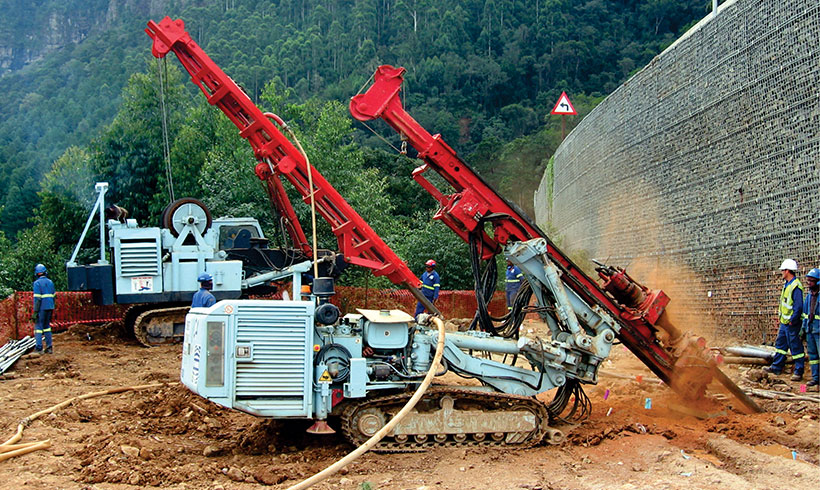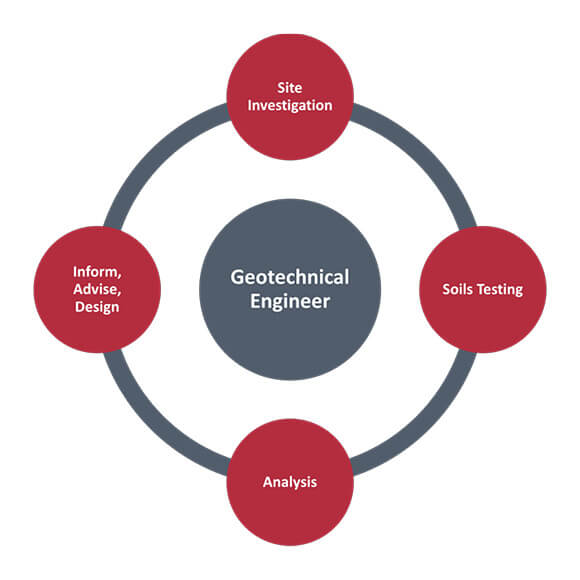How Geotechnical Engineering For Construction Projects can Save You Time, Stress, and Money.
How Geotechnical Engineering For Construction Projects can Save You Time, Stress, and Money.
Blog Article
A Biased View of Geotechnical Engineering For Construction Projects
Table of ContentsGeotechnical Engineering For Construction Projects Things To Know Before You Get ThisGeotechnical Engineering For Construction Projects Fundamentals ExplainedThe Best Strategy To Use For Geotechnical Engineering For Construction ProjectsGeotechnical Engineering For Construction Projects - TruthsThings about Geotechnical Engineering For Construction ProjectsGeotechnical Engineering For Construction Projects - An Overview
These attributes must be checked out by geotechnical designers to anticipate their activities under different situations., making this analysis essential.A geotechnical designer will certainly check out dirt to establish the bearing capacity of the planet and advise correct foundation kinds, such as shallow foundations, deep foundations like piles, or specialized services like floating foundations for soft soils. Recognizing the features and actions of dirt and rock, in addition to how they engage with buildings that have been erected on or within them, is just one of the main descriptions for why geotechnical engineering is necessary.
Environmental security is completed via geotechnical design. Know-how in air, water, and dirt quality maintenance is put to utilize by geotechnical engineers to reduce the adverse impacts of projects.
Infrastructure advancement, offshore engineering, passage building, and deep structures. Risk-based design and multidisciplinary groups. These components will keep the field evolving and guarantee its continued relevance in the years ahead. To sum up, geotechnical engineering is a vital technique that maintains the resilience and integrity of civil infrastructure. Geotechnical engineers add to making building jobs reliable all over the world by understanding the behavior of earth products and using appropriate preparation methods.
Some Ideas on Geotechnical Engineering For Construction Projects You Should Know
The fundamental security of any kind of task is imperative. Geotechnical design plays an important role in guaranteeing that structures are improved solid ground, actually and figuratively. By taking a look at dirt, rock, and subsurface problems, geotechnical engineers supply vital understandings that assist in the style, construction, and maintenance of buildings and framework.

Some Ideas on Geotechnical Engineering For Construction Projects You Should Know
Laboratory testing: Figuring out the buildings of soil and rock. Area testing: Carrying out examinations on-site to examine conditions. Analysis and design: Making use of data to design foundations, retaining wall surfaces, tunnels, and other structures. A number of prominent construction projects have efficiently made use of geotechnical design to ensure their stability and security. :: The world's highest building needed a deep understanding of the underlying geology.

As a leader in geotechnical design, BECC Inc. is dedicated to delivering cutting-edge and effective solutions that fulfill the greatest requirements of quality and security., a mechanical engineer and geologist.
Little Known Facts About Geotechnical Engineering For Construction Projects.
Terzaghi likewise established the framework for concepts of bearing capability of foundations, and the theory for prediction of the rate of negotiation of clay layers due to loan consolidation. helpful site After that, Maurice Biot totally established the three-dimensional soil combination theory, extending the one-dimensional model formerly established by Terzaghi to a lot more basic hypotheses and presenting the collection of standard formulas of Poroelasticity.
Geotechnical designers explore and establish the properties of subsurface conditions and products.
The smart Trick of Geotechnical Engineering For Construction Projects That Nobody is Discussing
Still, they are sometimes made use of to permit a rock hound or engineer to be lowered right into the borehole for direct aesthetic and hands-on exam of the soil and rock stratigraphy. Numerous dirt samplers exist to meet the needs of different design tasks. The typical infiltration examination, which uses a thick-walled split spoon sampler, is the most typical method to gather disrupted examples.

If the user interface between the mass and the base of an incline has a complex geometry, slope security evaluation is tough and mathematical option techniques are called for. Typically, the user interface's precise geometry is unknown, and a streamlined interface geometry is thought. you can try this out Finite inclines call for three-dimensional designs to be examined, so most slopes are assessed thinking that they are considerably vast and can be stood for by two-dimensional models.
Excitement About Geotechnical Engineering For Construction Projects
The empirical approach may be defined as follows: General exploration sufficient to establish the rough nature, pattern, and buildings of down payments. Analysis of the most likely problems and the most undesirable imaginable deviations. Creating the layout based upon a functioning hypothesis of behavior anticipated under Recommended Site the most potential conditions. Selection of quantities to be observed as building proceeds and determining their expected worths based on the functioning hypothesis under the most negative conditions.
Measurement of amounts and evaluation of real problems. It is unsuitable for projects whose style can not be modified during building and construction.
Report this page